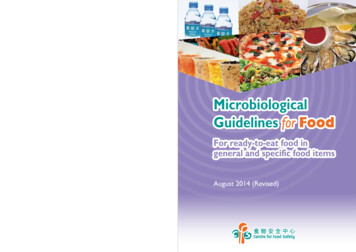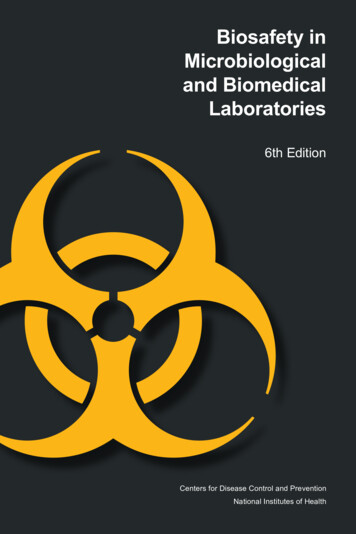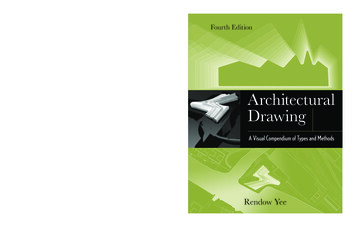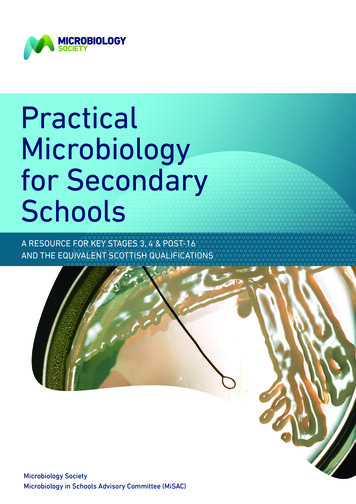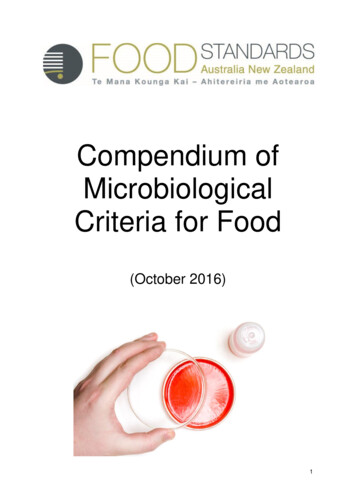
Transcription
Compendium ofMicrobiologicalCriteria for Food(October 2016)1
Food Standards Australia New Zealand 2016ISBN: 978-0-642-34594-3Published October 2016Food Standards Australia New Zealand (FSANZ) supports and encourages thedissemination and exchange of information. Information in this publication is provided undera Creative Commons Attribution 3.0 Australia (CC BY 3.0) Licence, except for the FoodStandards Australia New Zealand logo. An electronic version of this work is available on theFSANZ website at www.foodstandards.gov.au and, for New Zealand,www.foodstandards.govt.nz.AttributionYou may copy, distribute, transmit and adapt the material in this publication by the CC BY3.0 licence for commercial and non-commercial purposes; but you must attribute the work inthe following manner: Food Standards Australia New Zealand.This attribution must not, in any way, suggest that FSANZ endorses you or your use of thework.For more information email info@foodstandards.gov.auAustraliaPO Box 5423Kingston ACT 2604AUSTRALIAPh: 61 2 6271 2222Fax: 61 2 6271 2278New ZealandPO Box 10559, The TerraceWELLINGTON 6143Ph: 64 4 473 5630Fax: 64 4 473 98552
TABLE OF CONTENTSIntroduction. 4SECTION 1. 5Microbiological guideline criteria for RTE foods . 5Background . 5Purpose and scope . 5Microbiological tests. 5Summary of bacterial pathogen/food associations . 6Interpretation of results . 8Table 1. Interpreting results for testing of pathogenic microorganisms in ready-to-eatfood . 9Table 2. Interpreting results for testing of indicator organisms in ready-to-eat foods.15Table 3. Interpretation of results for mesophilic aerobic bacteria (MAB) colony count (at30 C) in RTE foods .17SECTION 2. 18Process hygiene criteria . 182.1Powdered infant formula products .19Process hygiene criteria .192.2Chicken meat .21Process hygiene criteria .21Method of analysis .23Attachment 1. System Assessment – Control Point Checklist . 25 Toc461446112APPENDIX 1Pathogens . 30Bacillus cereus & other Bacillus spp. .30Campylobacter spp. .32Clostridium perfringens .34Listeria monocytogenes.36Salmonella spp. (non-typhoidal) .38Shiga Toxin-producing Escherichia coli (STEC) .40Staphylococcus aureus .42Vibrio parahaemolyticus .44APPENDIX 2Indicator microorganisms . 46Enterobacteriaceae .46Coliforms .48Escherichia coli .48Mesophilic Aerobic Bacteria .493
IntroductionMicrobiological criteria are established to support decision making about a food or processbased on microbiological testing. Criteria can be developed and applied for differentpurposes across the food supply chain, with different consequences if the limits are not met.Internationally, the Codex Alimentarius Commission (Codex) and the InternationalCommission on Microbiological Specifications for Foods (ICMSF) have provided the lead oncontemporary food safety management approaches and applying microbiological criteria. Animportant principle is that a microbiological criterion is established at a specified point in thefood chain for a particular purpose. In general, this is to establish the safety of a food or toverify that the food safety control system or elements of it are working as intended.The microbiological criteria used by food regulatory agencies generally include: food safety criteria: microbiological criteria that are applied to determine the safety of afood lot. Food safety criteria are included in the Australia New Zealand Food StandardsCode (the Code) and are applied to food for sale (e.g. at any point following final productmanufacture). process hygiene criteria: microbiological criteria applied to verify hygiene measures orcontrol of process. Process hygiene criteria are included in Section 2 of this document.They are applied at a specified point in the manufacturing process.Microbiological guidelines are also used by regulatory agencies to check that food for saleis safe and suitable and the food handling controls and hygienic practices of a food businessare adequate. Guideline criteria indicate whether the microbiological status of a food productis within the normal/acceptable range and in this way are alert mechanisms to signalconformance with food safety controls. Microbiological guideline criteria for ready-to-eatfoods are included in Section 1.Food businesses may also establish process hygiene criteria and microbiological guidelinesfor their operations as well as setting microbiological specifications for raw materials andingredients or finished products. A microbiological specification is a criterion applied as partof purchase arrangements to determine acceptability of ingredients or foods as required forensuring product safety or quality.This compendium brings together information on pathogens and indicator organismssignificant to food safety; microbiological guideline criteria for ready-to-eat foods, andprocess hygiene criteria that have been established for specific food commodities.4
SECTION 1Microbiological guideline criteria for RTE foodsBackgroundReady-to-eat (RTE) foods1 are intended to be consumed without any further process by thefinal consumer that may eliminate or reduce pathogenic microorganisms that could bepresent to a safe level. They may be commodity based (e.g. dairy or meat products), butcommonly include a combination of ingredients from more than one commodity group.The safety and suitability of RTE foods should be ensured through adherence to foodhandling controls and good hygiene practices that prevent or minimise contamination by andgrowth of pathogenic microorganisms. In Australia these food safety requirements are set outin Chapters 3 and 4 of the Code. In New Zealand, the Food Act 2014 and Animal ProductsAct 1999 and associated regulations specify food handling controls. In this context,microbiological testing can be useful in checking/verifying whether food safety controls are inplace and working as intended.Purpose and scopeFood samples may be taken for a variety of surveillance and monitoring purposes. Whenmicrobiological testing of food samples is carried out it is important that relevant tests andsuitable limits are applied so results are interpreted correctly and consistently.The purpose of this section is to: provide information on which microbiological tests apply to RTE foods, based on theircharacteristics and processing factors outline criteria for assessment, including limits for interpreting results provide an indication of the type of follow-up actions to be taken in response to findings.The reference limits provided allow an assessment of a single or multiple samples. They arenot intended to be sampling plans for the acceptance/ rejection of food lots, but used forevaluating food handling controls.The guideline criteria for RTE foods provided in this document are not intended to be usedfor food products for which food safety criteria have been established in the Code. Processhygiene criteria for specific foods/commodities are provided in Section 2.Microbiological testsAs RTE foods include a wide range of products, the decision on what microbiological test toapply will depend on a number of factors: the type of ingredients used whether ingredients are cooked or raw the cooking or other processing involved in manufacture the level of handling after cooking or processing whether the food requires temperature control for safety (i.e. the characteristics of thefood, such as pH and water activity, allow the growth of pathogenic microorganisms) presence and type of packaging shelf life.1Ready-to-eat food is defined in Standard 3.2.2 of the Code.5
Appendices 1 and 2 provide information on pathogens and indicator microorganisms/testssignificant to food safety. A summary of bacterial pathogen/food associations for thosemicroorganisms routinely tested and applicable to RTE foods is provided below.Laboratory methods aren’t specified in this section. The method used will depend on thereason for testing and factors such as speed, sensitivity, whether identification orquantification is required, as well as cost. For regulatory testing against food safety criteria inSchedule 27 of the Code, Standard 1.6.1 specifies reference methods to be used. For othertesting, validated methods should be used.Summary of bacterial pathogen/food associationsPathogenAssociated foodsWhyBacillus cereusCooked foods such as: rice dishes including sushi potato and pasta dishes meat, vegetable and fishdishes (stews, curries etc.).Spores are widespread in theenvironment and may be present onraw ingredients. The spores surviveand are activated by cooking. Whenfood is then cooled too slowly ordisplayed out of temperature controlfor extended periods, warm conditionsallow for vegetative cells to grow tohigh levels and produce toxins.Campylobacter spp.Main food vehicles: Undercooked/improperlyhandled poultry Raw meat unpasteurised milk contaminated water.Campylobacter spp. can colonise theintestinal tract of food-producinganimals, such as chickens, cattle,sheep and pigs. Inadequateprocessing (e.g. undercooked poultry,unpasteurised milk) and crosscontamination of RTE foods or foodcontact surfaces with raw meat andpoultry can result in sufficient numbersbeing present in food to cause illness.Clostridium perfringensCooked foods such as: meats, particularly rolled andlarge joints meat containing products suchas stews, gravies, curries andpies vegetable dishes (curries,soups etc.)Spores are widespread in theenvironment and are a part of normalintestinal flora of animals. The sporessurvive and are activated by cooking.Slow cooling/reheating, particularly oflarge volumes of food, provides warm,anaerobic conditions that allow forvegetative cells to grow to high levelsthat cause illness when ingested.RTE foods that can support thegrowth of L. monocytogenes andhave an extended refrigeratedshelf life. Foods that have beenassociated with outbreaks includesoft cheeses, delicatessen meats,cooked chicken, smoked seafood,salads and rockmelon.L. monocytogenes is widespread inthe environment and able to persist infood processing environments. RTEfoods can become contaminated postprocessing through contaminationfrom food-contact surfaces. L.monocytogenes is able to grow atrefrigeration temperatures and canreach high levels in food that supportsits growth.A wide range offoods have been implicated inoutbreaks of foodborneSalmonella is widely dispersed in theenvironment. A primary reservoir isthe intestinal tracts of vertebrates,Listeria monocytogenesSalmonella spp.6
PathogenAssociated foodsWhysalmonellosis: animal products such as eggs(particularly raw or lightlycooked egg dishes), poultry,raw meat, milk and dairyproducts fresh produce (such as leafygreens, seed sprouts, melons) low moisture foods such asspices, peanut butter,chocolate and flour.Foods include: inadequately cooked groundbeef (hamburger patties) uncooked fermentedcomminuted meat (e.g.salami) raw or inadequatelypasteurised dairy products(milk and cheese) fresh produce such as leafygreens and sprouted seeds.including livestock, wildlife, domesticpets, and humans. Contaminated rawfoods that are eaten without furtherprocessing (such as cooking); crosscontamination during food handlingand poor hygiene and temperaturecontrol practices are factorscontributing to food bornesalmonellosis.Staphylococcus aureusA variety of foods, particularlythose high in protein and requiringextensive handling duringpreparation. These can include: meat and meat products poultry and egg products milk and dairy products cream or custard filled bakeryproducts sandwich fillings.Food handlers are the main source offood contamination via direct contact(staphylococci can normally bepresent in people’s nasal passages,throat and skin). Contamination offood can occur via hands orrespiratory secretions. Time andtemperature abuse of contaminatedfood can result in growth of S. aureusand production of enterotoxin in thefood.Vibrio parahaemolyticusFish, shellfish and crustaceans(particularly raw molluscs andcrustacea) are predominantlyassociated with foodborne illnesscaused by V. parahaemolyticus.V. parahaemolyticus occurs in coastaland estuarine waters and is a naturalcontaminant of seafood. Initial levelswill depend on environmental factorsat harvest. Illness is associated witheating raw or lightly cooked seafood,or cooked seafood that has beencross contaminated. Inadequaterefrigeration of seafood contaminatedwith V. parahaemolyticus allowsgrowth to levels that cause illness.Shiga Toxin-producingEscherichia coli (STEC)Ruminants, in particular cattle andsheep, are the major animal reservoirof STEC. Infected animals shed thebacteria in their faeces, resulting incontamination of the environment.Primary products (such as meat, milkand fresh produce) can be eithercontaminated directly by faecalmaterial or indirectly via contaminatedwater or soil. STEC infection isassociated with contaminated foodsthat are eaten without furtherprocessing or have been inadequatelyprocessed.7
Interpretation of resultsThe tables below provide guidance on interpreting results for the microbiological examinationof RTE foods for pathogenic microorganisms and for indicator microorganisms. The limitsapply to foods sampled in the retail chain (i.e. food for sale at retail, food service wholesaleand distribution) up to and including end of shelf life.There are four categories of microbiological assessment defined based on the detection orlevel of microorganism found: Satisfactory: results are within expected microbiological levels (lower range) andpresent no food safety concern. No action required. Marginal: results are within expected microbiological levels but are at the upper range.Some action may be required to ensure food handling controls continue to be effective. Unsatisfactory: results are outside expected microbiological levels and indicate poorfood handling practices. Further actions are required to re-establish effective foodhandling controls. Potentially hazardous: results exceed expected microbiological levels to a level thatpresents an immediate food safety concern. Further action is required to:ooprevent affected product still available from being distributed or solddetermine the likely source/cause of the problem and ensure corrective actionsare implemented.Interpretation of results should also be based on knowledge of the food product and theproduction process. Care must be taken when interpreting results obtained in the absence ofthis information.8
Table 1. Interpreting results for testing of pathogenic microorganisms in ready-to-eat food2HazardResult(cfu/g)Bacillus cereus and otherpathogenic Bacillus spp. 105InterpretationLikely causeActionsPotentiallyhazardousInadequate time and temperature control duringcooling and subsequent storage allowing sporesto germinate and multiply. Product disposition action required to assess safety anddetermine if disposal or product recall is required.Reprocessing of product not an option due to potentialfor toxin formation. Investigate and review temperature and time profilesused for the cooling and storage of cooked foods. Identify high risk raw ingredients and consider limits forB. cereus. Investigate pH and acidification process (as applicable)The use of poor quality highly contaminated rawingredients, such as plant based powders andspices, may also be a contributing factor.Inadequate acidification of foods using pH tocontrol growth (e.g. acidified rice for sushi).35UnsatisfactoryAs above. Investigate and review temperature and time profilesused for the cooling and storage of cooked foods. Identify high risk raw ingredients and consider limits forB. cereus.23MarginalProcess controls not fully achieved or possibleraw material contamination. Proactive investigation to ensure temperature and timeprofiles used for cooling and storage of cooked foods arebeing implemented. Assess quality of high risk raw ingredients.Inadequate time and temperature control duringcooling, storage, processing or reheating. Slow orinadequate cooling, reheating or cooking of largeproduction volumes a possible factor. Product disposition action required to assess safety anddetermine if disposal or product recall is required.Reprocessing of product not an option due to potentialfor toxin formation. Investigate and review temperature and time profilesused for the cooling and storage of cooked foods (i.e.times taken to reach required internal temperatures).10 – 1010 – 102Satisfactory5Potentiallyhazardous 10Clostridium perfringens 102Table 1 does not include an exhaustive list of pathogens and for some foods/circumstances, testing of other microorganisms may be appropriate. The microbiological testingapplied should be appropriate to the type of food being examined and the handling it has received.9
HazardResult(cfu/g)InterpretationLikely causeActions Assess capacity of business and equipment used toeffectively process the volume of food handled.35UnsatisfactoryAs above. Investigate and review temperature and time profilesused for the cooking, cooling, storage and reheating ofcooked foods (i.e. times taken to reach required internaltemperatures). Assess capacity of business and equipment used toeffectively process the volume of food handled.23MarginalProcess controls not fully achieved. Proactive investigation to ensure temperature and timeprofiles used for cooling, processing, reheating andstorage of cooked foods are being implemented.Inadequate temperature control and poorhygienic practices. Product disposition action required to assess safety anddetermine if disposal or product recall is required.Reprocessing of product not an option due to potentialfor toxin formation. Food handling practices should be investigated to: ensure all practicable measures are beingundertaken by food handlers to prevent unnecessarycontact with RTE food ensure good levels of personal hygiene review temperature and time controls. Testing for enterotoxin should be considered where casesof food-borne illness are suspected.10 – 1010 - 102Satisfactory4Potentiallyhazardous 10Staphylococcus aureus 1010
HazardResult(cfu/g)UnsatisfactoryAs above Food handling practices should be investigated as above. The level of S. aureus determined at the time of analysismay not be the highest level that occurred in the food. Ifcases of foodborne illness are suspected, testing forenterotoxin should be considered.23MarginalHygiene and handling controls not fully achieved. Proactive investigation to ensure hygiene practices andtemperature controls are effectively implemented.Post-processing or post-harvest contamination orinadequate process control. Product disposition action required to assess safety anddetermine if disposal or product recall is required.Vulnerability of population to be considered. An investigation should be undertaken of: the raw materials used; adequacy of cleaning and sanitising of premises andequipment, particularly of preferred sites such asdrains adequacy of construction and maintenance ofpremises the effectiveness of processing controls the adequacy of process flow. Increased sampling, including environmental sampling.2 10SatisfactoryDetected in25gPotentiallyhazardousHigher levels in product in the marketplace maybe due to poor temperature control duringstorage and/or distribution or inappropriatelength of shelf life.Notdetected in25g2. RTE food in whichgrowth of Listeriamonocytogenes will not3Actions410 - 103Likely cause310 – 10Listeria monocytogenes1. RTE food in whichgrowth of Listeriamonocytogenes canoccurInterpretation2 10SatisfactoryPotentiallyhazardousPost-processing or post-harvest contamination orinadequate process control. Product disposition action required to assess safety anddetermine if disposal or product recall is required.Vulnerability of population should be considered.Schedule 27 of the Code specifies microbiological criteria for RTE food on the basis of whether growth of L. monocytogenes can occur or will not occur.11
HazardResult(cfu/g)InterpretationLikely cause An investigation should be implemented as above.occurDetected2but 10Indicates better process control required. While regulatory limits are met, the presence of L.monocytogenes should be investigated in the case of afood that has received a listericidal process. For foodsthat have not, ongoing trend analysis should be used tomonitor levels. Product disposition action may be required to assesssafety and determine if disposal or recall is required.Vulnerability of population should be considered.PotentiallyhazardousPoor temperature control (rapid chilling andstorage at 5 C), inadequate processing, crosscontamination or high contamination levels inharvested seafood.UnsatisfactoryAs above Product disposition action required to assess safety anddetermine if disposal or product recall is required. Mayneed confirmation to determine whether the geneticmarkers of virulence are present and that the V.parahaemolyticus are able to cause disease. An investigation should be undertaken to assess: the source of raw product and potential for highlevels of contamination (e.g. harvest watertemperature and water salinity) the adequacy of the time and temperature controls(chilling and storage) implemented post-harvest the adequacy of the processing used (e.g. adequatecooking) likelihood of cross contamination Confirmation of identity and typing may be requiredwhere cases of food-borne illness are suspected. An investigation should be undertaken as above.Satisfactory if alistericidalprocess has notbeen applied.Marginal if alistericidalprocess has beenapplied.Absent in25gVibrio parahaemolyticusActions4 10210 - 104Satisfactory12
HazardResult(cfu/g) 3 – 10Shiga toxin producingEscherichia coli (STEC)Campylobacter spp.2InterpretationLikely causeActionsMarginalIndication that temperature control or foodhandling controls are not fully achieved.It may be expected that naturally contaminatedraw seafood may have low levels present ( 100cfu/g). Proactive investigation to ensure temperature and foodhandling controls are effectively implemented.Inadequate processing of raw products or crosscontamination of raw materials and preparedfoods. Poor time and temperature control is acontributing factor for multiplication. Inadequate processing of raw products(especially poultry and raw milk) or crosscontamination of raw materials and preparedfoods. The use of inadequately treated water canalso be a factor. Product disposition action required to assess safety anddetermine if disposal or product recall is required. An investigation should be undertaken to assess: the adequacy of processing used (e.g. adequatecooking; pasteurisation) the adequacy of measures implemented to preventthe likelihood of cross contamination the possibility of untreated water being used. 3SatisfactoryDetected in25gPotentiallyhazardousNotdetected in25gSatisfactoryDetected in25gPotentiallyhazardousProduct disposition action required to assess safety anddetermine if disposal or product recall is required. An investigation should be undertaken to assess: Raw material suitability the adequacy of processing used (e.g. adequatecooking, pH, water activity) the adequacy of measures implemented to preventthe likelihood of cross contamination the adequacy of time and temperature controlsused.Additional sampling of foods and environmental samplesmay be required.Confirmation of toxigenic strains and serotyping requiredwhere cases of foodborne illness suspected.13
HazardSalmonella spp.Result(cfu/g)InterpretationNotdetected in25gSatisfactoryDetected in25gPotentiallyhazardousNotdetected in25gLikely causeActionsEnsure sample has not been frozen as results may not beaccurate (Campylobacter levels are reduced by freezing)Inadequate processing of raw products, crosscontamination or contaminated raw materials.Poor time and temperature control is acontributing factor for multiplication. Product disposition action required to assess safety anddetermine if disposal or product recall is required. An investigation should be undertaken to assess: Raw material suitability the adequacy of processing used (e.g. adequatecooking, pH, water activity) the adequacy of measures implemented to preventthe likelihood of cross contamination the effectiveness of cleaning and sanitisingequipment (e.g. blenders, vitamisers, otherprocessing equipment) the adequacy of time and temperature controlsused. The adequacy of health and hygiene practices may alsorequire investigation if an infected food handler issuspected. Confirmation of identity, serotyping, phage typingrequired where cases of foodborne illness suspected.Satisfactory14
Table 2. Interpreting results for testing of indicator organisms in ready-to-eat foodsIndicatorResult (cfu/g)Enterobacteriaceae44 10Interpretation Likely causeActionsUnsatisfactoryFor processed foods indicates thatcontamination has occurred post processing(cross contamination from food contactsurfaces, raw products or food handlers) orthere has been inadequate processing. Poortemperature time control may also be acontributing factor. Review: processing controls used (such as cookingtemperatures) cleaning and sanitising practices for premises andequipment food handler hygiene time and temperature control.Additional food or environmental samples may berequired for investigation.MarginalSome cross contamination or inadequateprocessing indicated.Proactive investigation to ensure processing andhygiene controls are being implemented.Results may need to be compared with other foodsamples from the production environment forinterpretation.For raw and processed foods indicatespotential for there to have been contaminationof faecal origin from poor hygienic practices(cross contamination from food contactsurfaces, raw foods or food handlers) or therehas been inadequate processing. Review: processing controls used (such as cookingtemperatures) cleaning and sanitising practices for premises andequipment food handler hygiene time and temperature control primary production controls (e.g. harvestpractices, water quality, fertilizers, other inputsas appropriate).(includes coliforms)2410 –102Satisfactory2Unsatisfactory 105Escherichia coli 10For RTE foods that have not been processed(e.g. fresh produce), contamination from theprimary production environment should beconsidered.Additional food or environmental samples may berequired for investigation and testing for enteric4Process hygiene criteria and associated actions for Enterobacteriaceae in specific food products are provided in Section 2.5Process hygiene criteria and associated actions for E. coli in specific food products are provided in Section 2.15
IndicatorResult (cfu/g)Interpretation Likely causeActionspathogens considered if appropriate.3 - 102 3Listeria spp.(other than L.monocytogenes)MarginalWhile low levels may occasionally be found inRTE food, widespread detection in severalfoods or areas of the food productionenvironment suggests poor
whether the food requires temperature control for safety (i.e. the characteristics of the food, such as pH and water activity, allow the growth of pathogenic microorganisms) presence and type of packaging shelf life. 1 Ready-to-eat
